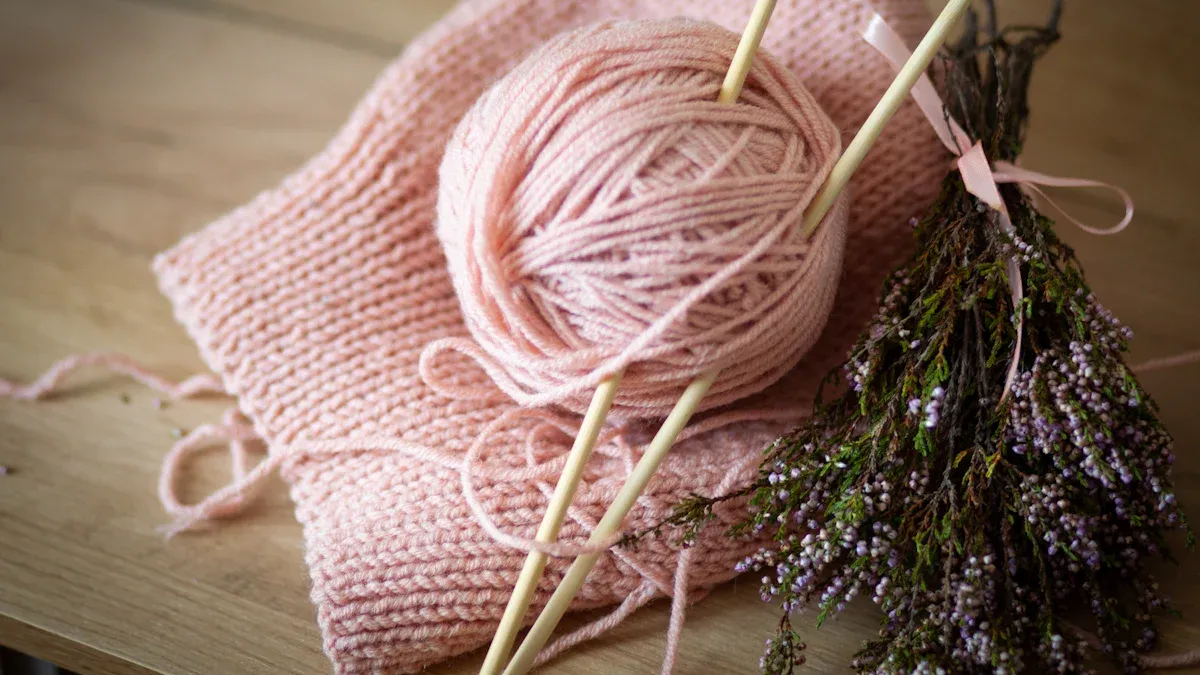
You want to start knitting but wonder what you need. Grab these Knitting Essentials before you begin: needles, yarn, scissors, a tapestry needle, stitch markers, and a measuring tape. These simple tools help you create your first project with ease. You can find most supplies at a local craft store for a low price. Keeping your tools organized makes knitting even more fun. Reliable resources and guides are easy to find online or at your library.
Key Takeaways
Gather basic knitting tools like needles, yarn, scissors, and stitch markers to start your projects easily.
Learn the core skills: casting on, knit and purl stitches, and binding off to create neat and strong pieces.
Choose yarn and needles that match your project for better results; try different combinations to find what feels best.
Practice simple projects like scarves or dishcloths to build confidence and improve your knitting skills.
Keep your supplies organized in a project bag or container to save time and enjoy knitting more.
Knitting Essentials
Getting started with knitting feels easy when you have the right tools. Let’s look at each item you’ll want in your kit.
Needles
You need knitting needles to make every stitch. They come in different sizes and materials. Some are metal, some are bamboo, and others are plastic. The size and type affect how your project feels and looks. Here’s a quick table showing how needle choices and yarn types can impact your knitting:
Needle Type | Yarn Type | Structure | Stitch Length | Fabric Quality |
|---|---|---|---|---|
Metal | Wool | Plain | Tight | Dense |
Bamboo | Cotton | 2×2 Rib | Standard | Soft |
Plastic | Acrylic | 1×3 Rib | Slack | Stretchy |
Yarn
Yarn brings color and texture to your projects. You’ll find many types, from soft wool to smooth cotton and easy-care acrylic. Each yarn has its own feel and strength. For example:
Egyptian cotton yarn lasts longer and keeps colors bright.
Yarn can be thick or thin, soft or strong, stretchy or firm.
Some yarns have special certifications for quality.
Scissors
A small, sharp pair of scissors helps you cut yarn cleanly. Keep them handy so you can trim ends or fix mistakes quickly.
Tapestry Needle
You use a tapestry needle to weave in loose yarn ends. Its large eye makes threading yarn easy. It also helps you sew pieces together.
Stitch Markers
Stitch markers help you keep track of pattern changes or mark important spots. You can use plastic rings or even a scrap of yarn.
Stitch Holders
Stitch holders save your stitches when you need to set them aside. They look like big safety pins and keep your work safe.
Measuring Tape
A measuring tape checks your progress and helps you size your project. For best results:
Use a hard ruler for gauge, as it stays straight.
Measure across the middle of your swatch, not the edges.
Always check your gauge after washing your swatch.
Crochet Hook
A crochet hook fixes dropped stitches and helps with finishing touches. Even if you don’t crochet, it’s a handy tool for every knitter.
Project Bag
A project bag keeps your Knitting Essentials together. Many knitters say project bags stop yarn from tangling and make it easy to find what you need. Bags come in many styles and protect your supplies from damage.
Needle and Yarn Gauges
These small tools help you check needle sizes and yarn thickness. They make sure you use the right tools for your project.
Tip: Keeping your Knitting Essentials organized in a project bag or labeled container saves time and prevents frustration. You don’t need to spend much—basic supplies cost little, and you can always add more tools as you go.
Getting Started
Learning to knit starts with a few simple steps. You build your skills by practicing the basics. Once you know these, you can make scarves, hats, or even sweaters. Let’s break down the first things you need to learn.
Casting On
Casting on means putting the first loops of yarn onto your needle. This step sets up your whole project. You can use different methods, but the long-tail cast-on is a favorite for beginners. It gives you a neat edge and works for most projects. Try casting on 20 stitches and practice until you feel comfortable. You’ll use this skill every time you start something new.
Basic Stitches
You only need to know two stitches to begin: the knit stitch and the purl stitch. These form the base for almost every pattern. When you master these, you can create many textures and designs. Practicing these stitches helps you control your yarn and keep your work even.
Mastering stitch length and tension makes your knitting look neat.
Measuring your work with a ruler helps you keep stitches even.
Using the right tools, like a measuring tape, prevents mistakes.
You’ll notice your projects look better as you practice these basics.
Binding Off
Binding off finishes your project and keeps it from unraveling. You use this step when you reach the end of your knitting. The basic bind-off is easy to learn. Practice binding off on your sample swatch. This step gives your work a clean edge.
Reading Patterns
Patterns guide you through each project. At first, they might look confusing, but you’ll get used to the terms and symbols. Reading patterns builds your confidence and helps you try new things. Many knitters find that following patterns also boosts focus and creativity.
Tip: Start with a simple scarf or dishcloth. These projects let you practice casting on, basic stitches, and binding off. You’ll see your progress and feel proud of your first finished piece!
Choosing Yarn and Needles
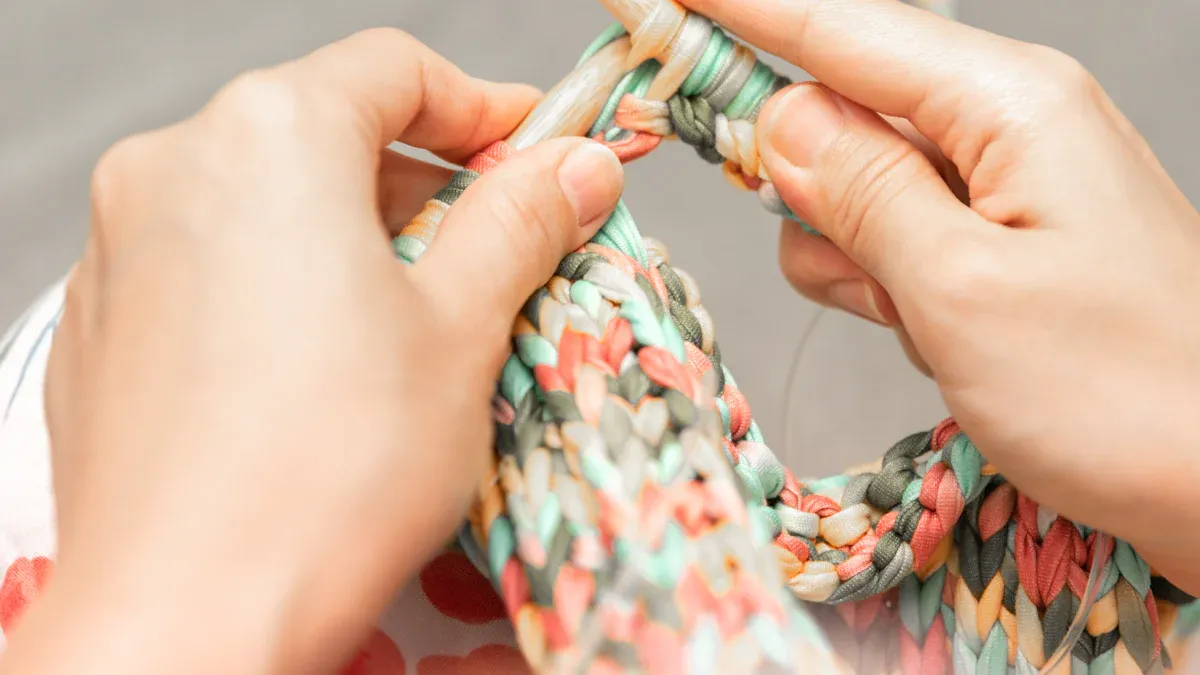
Picking the right yarn and needles can make your knitting project easier and more fun. You have many choices, but a few simple tips help you match your tools to your project. Let’s break down what you need to know.
Yarn Weights
Yarn comes in different thicknesses, called weights. Each weight works best for certain projects. Thicker yarns knit up quickly and make warm, chunky items. Thinner yarns create lighter, more delicate pieces.
Super Bulky: Great for scarves and blankets. Projects finish fast.
Worsted: Good for sweaters, hats, and mittens. Easy to handle.
DK (Double Knitting): Nice for lighter sweaters and baby clothes.
Sport and Fingering: Best for socks, shawls, and fine details.
Yarn weight also affects how strong and long-lasting your project will be. Studies show that finer yarns (lower weight) often hold up better after washing and keep their strength over time. Thicker yarns may feel softer but sometimes wear out faster, especially if you use them for items that get a lot of use.
Tip: Always check the yarn label for weight and recommended needle size. This helps you get the right look and feel for your project.
Fiber Types
Yarn can be made from many fibers. Each one feels different and works best for certain projects.
Fiber Type | Feel | Best For | Care |
|---|---|---|---|
Wool | Warm, stretchy | Hats, sweaters, socks | Hand wash or gentle cycle |
Cotton | Cool, smooth | Dishcloths, summer tops | Machine wash |
Acrylic | Soft, light | Blankets, kids’ items | Machine wash |
Bamboo | Silky, drapey | Shawls, baby clothes | Hand wash |
Wool yarn works well with bamboo or plastic needles. Cotton yarn often feels best on metal needles because the yarn slides smoothly. Acrylic yarn is easy to use and works with any needle type. You might want to try a few different fibers to see which one you like best.
Needle Types
You have several types of knitting needles to choose from. Each type fits different projects and styles.
Straight Needles: Good for flat pieces like scarves or dishcloths.
Circular Needles: Useful for knitting in the round or for large projects. You can also use them for flat knitting.
Double-Pointed Needles (DPNs): Perfect for small tubes, like socks or sleeves.
Circular needles come in two main styles. Fixed circular needles have the tips and cable attached. Interchangeable circular needles let you change the tips and cable length. Many knitters like interchangeable sets because they work for many projects.
The market for circular needles keeps growing. More people want high-quality, flexible tools for home projects. You can find circular needles in most craft stores and online shops.
Needle Materials
Needles come in many materials. Each one changes how your yarn moves and how your stitches look.
Material | Feel & Use | Pros | Cons |
|---|---|---|---|
Metal | Smooth, fast | Great for quick knitting, precise stitches | Can be slippery, cold to touch |
Bamboo/Wood | Warm, grippy | Good control, eco-friendly | Can break if thin, slower knitting |
Plastic | Light, flexible | Cheap, good for beginners | Less durable, can bend |
Carbon Fiber | Strong, light | Smooth, high speed | More expensive |
Metal needles help you knit quickly. They work well with cotton yarn, which can stick to other needles. Bamboo and wood give you more control, especially with slippery yarns like wool. Plastic needles are light and easy to use, but they may not last as long. Some knitters like carbon fiber needles for their strength and smooth feel.
Many knitters notice that needle material changes the size and shape of their stitches. Metal needles often make stitches longer and narrower because the yarn slides more. Bamboo or wood holds the yarn tighter, making stitches shorter and wider. If you switch needle materials in the middle of a project, your fabric might look uneven. Try to use the same type of needle for the whole project.
Pairing Yarn and Needles
Matching your yarn and needles makes a big difference. If you use thick yarn with small needles, your fabric will feel stiff. Thin yarn with big needles creates a loose, airy look. The right pairing gives you the best results.
Let’s look at some good matches:
Wool yarn with bamboo needles: Great grip, easy control.
Cotton yarn with metal needles: Smooth movement, less hand strain.
Acrylic yarn with plastic or metal needles: Flexible and easy to handle.
You can also get creative. Some knitters hold two strands of thin yarn together to make a thicker yarn. Using a medium-sized needle with this combo gives you a fabric that feels bouncy and soft. This trick works well for sweaters and lets you play with color.
Note: Always knit a small sample (called a swatch) before starting your project. This helps you see how your yarn and needles work together. You can check your stitch size and make sure your project will fit.
Choosing the right yarn and needles is part of your Knitting Essentials. When you match your tools to your project, you get better results and enjoy the process more. Try different combinations to find what feels best for you.
Tips and Resources
Common Mistakes
Everyone makes mistakes when learning to knit. You might drop a stitch or twist your yarn. Don’t worry—these slip-ups help you learn. If you notice a mistake, stop and look at your work. Use a crochet hook to pick up dropped stitches. Count your stitches often to stay on track. Many beginners knit too tightly or too loosely. Try to relax your hands and keep your stitches even. If you get stuck, ask a friend or search for a video online. Remember, every knitter started as a beginner!
Tip: Mistakes are part of the process. Each one teaches you something new.
Practice Projects
Start with small, simple projects. A scarf or dishcloth lets you practice casting on, basic stitches, and binding off. Try making a set of coasters or a headband. These projects finish quickly and help you see your progress. You can also knit a square and turn it into a patchwork blanket later. Choose patterns with clear instructions and not too many steps. You’ll feel proud when you finish your first project!
Organizing Supplies
Keeping your tools in order saves time and stress. Use a project bag or a box with dividers. Store your needles in a case or roll them in a cloth. Put stitch markers and tapestry needles in a small tin or pouch. Label your yarn by weight and color. A tidy space helps you find what you need fast. Many knitters say that organizing supplies makes knitting more relaxing.
Books and Patterns
You can find many great books and patterns to guide your knitting journey. Some books stand out for their clear instructions and helpful tips. For example, Stitch ‘N Bitch: The Knitter’s Handbook by Debbie Stoller gets perfect ratings for its easy-to-follow lessons. Knitting Rules! by Stephanie Pearl-McPhee offers practical advice and encouragement. A Treasury of Knitting Patterns by Barbara G. Walker is a classic with lots of stitch ideas. Many knitters love Mason-Dixon Knitting for its fun stories and creative patterns. The Knitter’s Book of Yarn by Clara Parkes helps you choose the best yarn for your projects. Alice Starmore’s Charts for Color Knitting is a favorite for colorwork fans, with deep and useful charts.
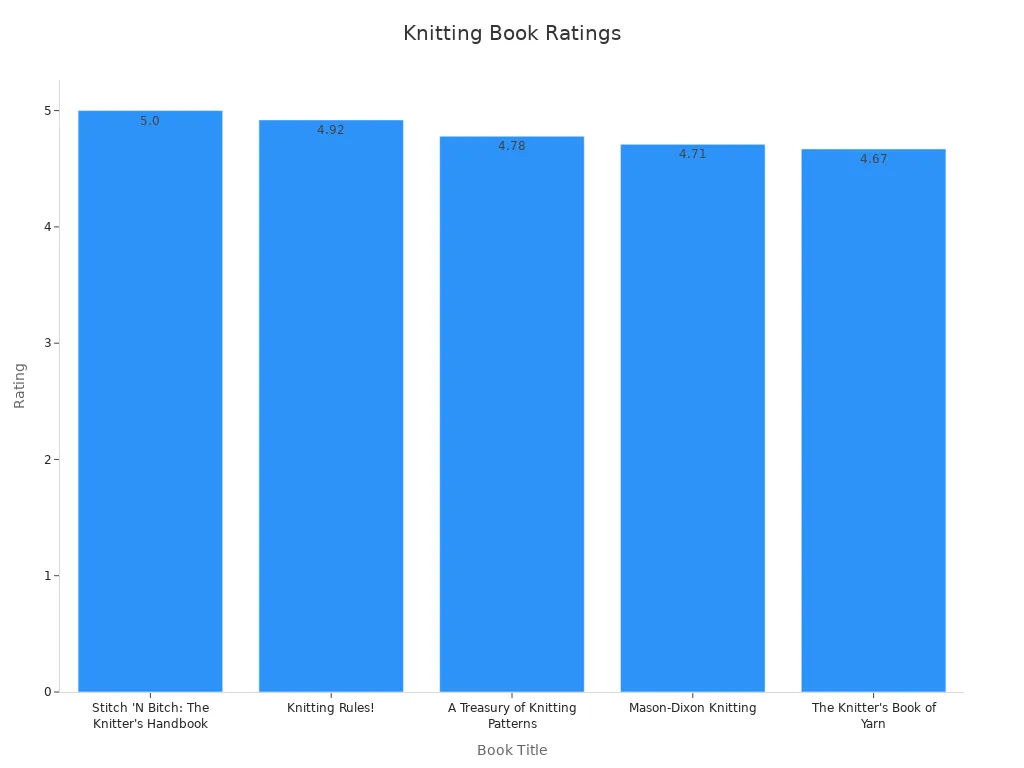
You can also find patterns on blogs, library websites, and knitting forums. Look for patterns with lots of photos and step-by-step guides. Trusted books and online resources help you build skills and confidence.
You now know the Knitting Essentials that help you start strong. Here’s what matters most:
Mastering basic tools and materials gives you confidence.
Learning stitches and pattern reading opens up new projects.
Fixing mistakes and using accessories keeps your work neat.
Try a simple project and practice these skills. Keep your tools organized for a smoother time. Check out books and patterns, then share your progress with others. Every step brings you closer to making something special.
FAQ
What is the best yarn for beginners?
You might want to start with medium-weight acrylic yarn. It feels soft, costs little, and does not split easily. This yarn helps you see your stitches clearly. You can find it in many colors at most craft stores.
How do I fix a dropped stitch?
Grab a crochet hook. Slide the hook through the dropped loop. Pull the loose yarn through each stitch above until you reach the top. Place the stitch back on your needle. You can watch a quick video online if you get stuck.
How do I keep my stitches even?
Relax your hands.
Try not to pull the yarn too tight.
Practice with the same yarn and needles.
You will see your stitches improve as you knit more. Everyone gets better with practice!
Can I knit without special tools?
Yes! You only need yarn and two needles to start. You can use pencils or chopsticks if you do not have knitting needles. Other tools, like stitch markers or tapestry needles, just make things easier.



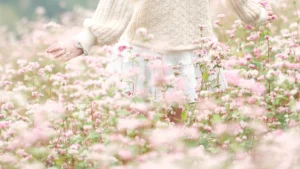
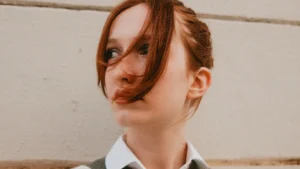
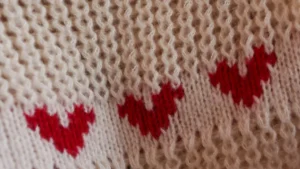
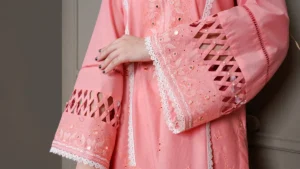
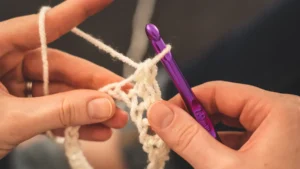


1 thought on “Mastering Knitting Essentials: From Casting On to Choosing the Right Yarn and Needles”
Pingback: Seasonal Style, Technical Precision: Crafting Every Knitted Dress – from Easy Autumn Staples to Statement Cable Sweater Silhouettes